2024 Toyota Highlander Review and Test Drive
Popular midsize three-row SUV is the quirky cousin you can't help but love.
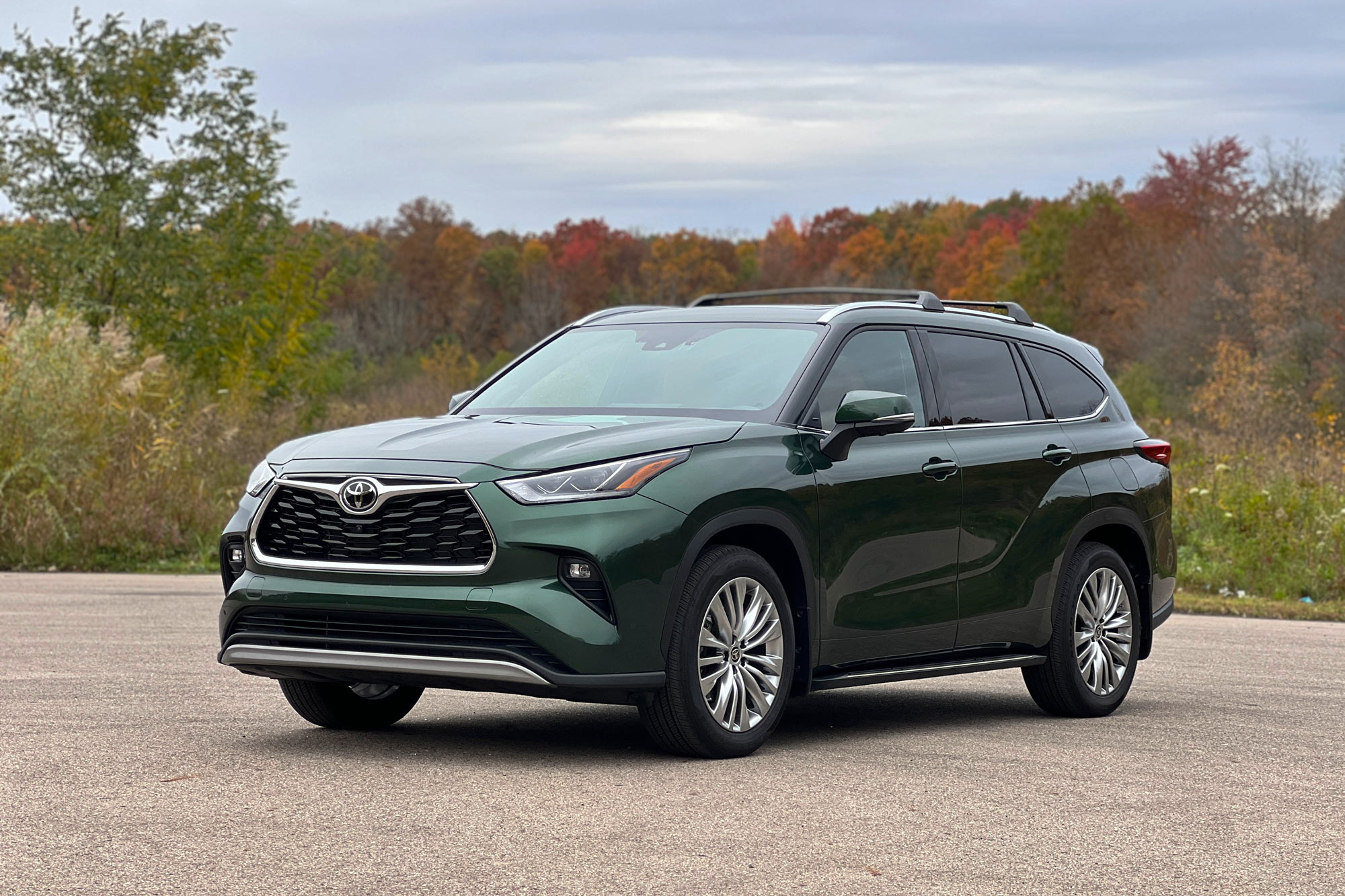 Beverly Braga
Beverly Braga
I don't pay much attention to car colors unless they're of the personalized variety. More often than not, this means a distinctive shade of loud and obnoxious. However, on this particular day, a Toyota — yes, a Toyota — got me saying, "Huh, I kinda like that."
It had to be a shiny sports car, right? Nope, it was a crossover SUV. A 2024 Toyota Highlander, to be precise. The paint color is a dark green called Cypress. Added to the palette last year, it's not a special paint and it doesn't even cost extra. But my test drive occurred in the fall, in Michigan, during the peak leaf-peeping week. Timing is everything, as they say, and this evergreen Highlander fits the narrative perfectly.
Fall foliage aside, there was more change in the seasons than with the 2024 Highlander, which was completely redesigned in 2020. The fourth-generation family hauler has only seen minor changes since. For 2024 Toyota discontinued the entry-level L trim and added a hands-free power liftgate for mid-level trims. For Highlander Hybrid models, the Bronze edition is dropped and swapped with the new Nightshade grade.
 Beverly Braga
Beverly Braga
No Cheap Seats in the 2024 Toyota Highlander
Toyota sells the Highlander in LE, XLE, XSE, Limited, and Platinum trim levels with standard front-wheel drive (FWD), but all trims are available with all-wheel drive (AWD). This year, 2024 Toyota Highlander prices range from the low $40,000s to the low $50,000s, including the destination charge to ship the vehicle from the Princeton, Indiana, factory that builds it to your local dealership.
For this 2024 Highlander review, I test-drove an AWD-equipped Platinum model in the metro Detroit area. It came with optional equipment such as carpeted floor mats, door edge guards, running boards, a dash cam, and roof rail cross bars, bringing the manufacturer's suggested retail price to $54,757, including the $1,395 destination fee. Toyota provided the vehicle for this Highlander review.
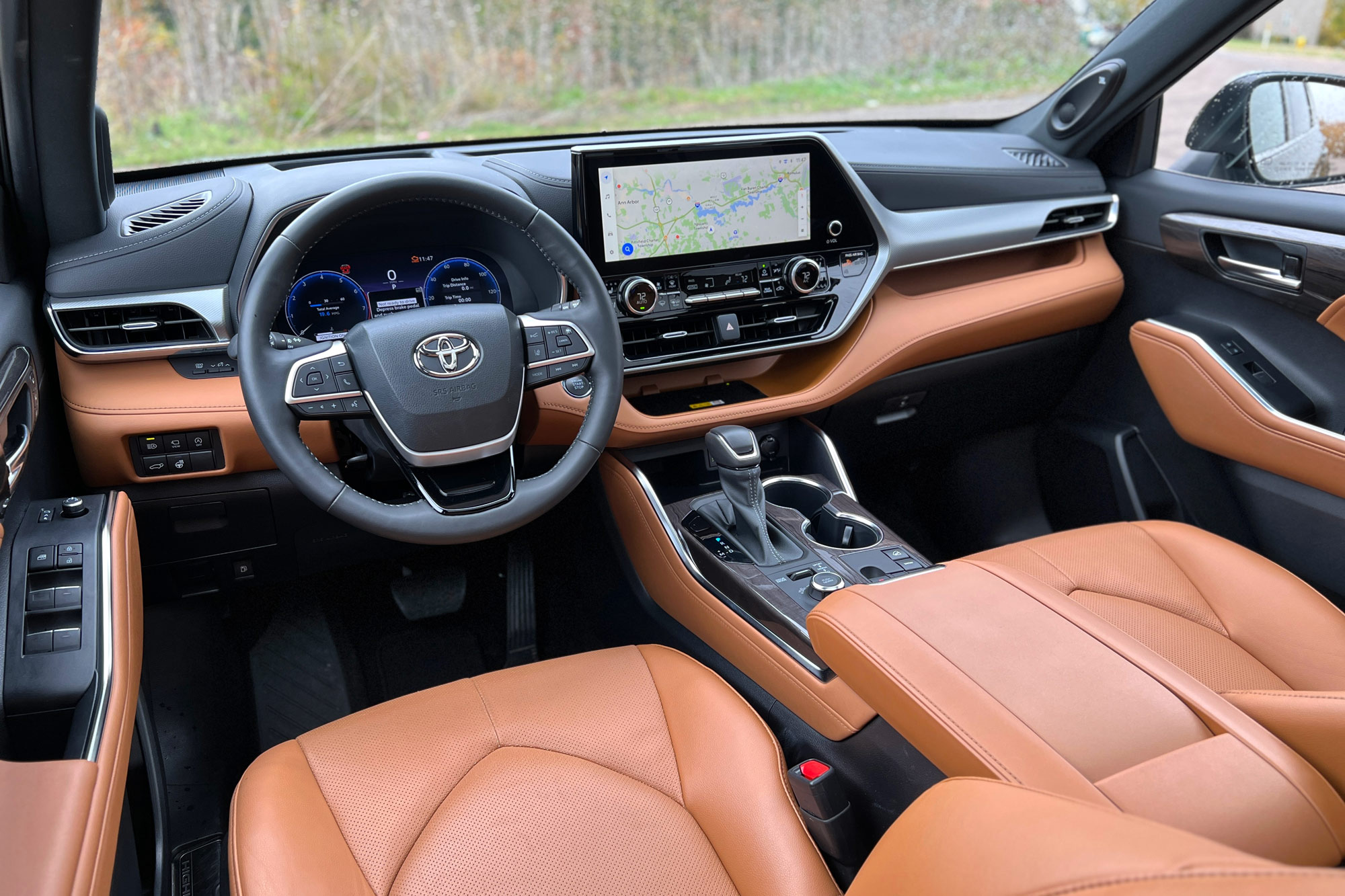 Beverly Braga
Beverly Braga
Minimalist Styling With Plenty of Substance
Being a Toyota, there is nothing offensive about the Highlander's looks. There is nothing overly exciting, either, except when that deep forest green exterior is juxtaposed against leaves attempting their best impression of a golden sunrise. But I digress.
Overall, the Highlander design features the right amount of kinks and curves to make the SUV more shapely and less frumpy.
Toyota outfitted my Highlander Platinum's interior in a two-tone scheme of charcoal and Deep Caramel leather. As the top-of-the-line version of the Highlander, my test vehicle also featured ornamental metallic details and faux wood trim. The 12.3-inch touchscreen display is the prominent interior feature, but there remains a good number of physical knobs, buttons, and switches. These frequent touchpoints are laid out well, are easy to read, and create minimal distraction for the drive and the design.
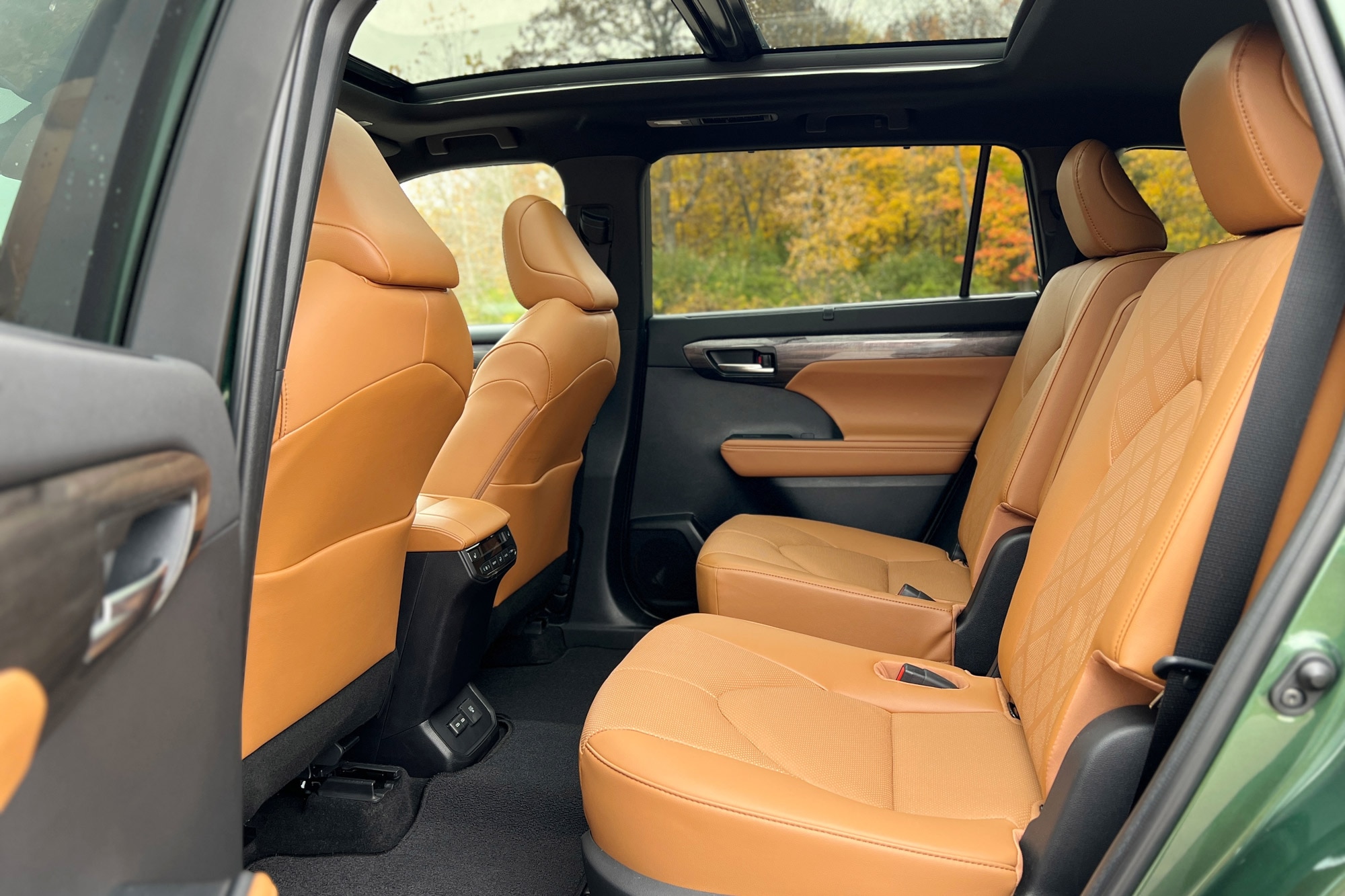 Beverly Braga
Beverly Braga
Mind the Gap — or Lack Thereof
All Highlander models, regardless of drive configuration and trim, have three rows of seating. The LE comes standard with a second-row bench for eight passengers. All others feature captain's chairs in the second row, but you can option the XLE and Limited models with a bench seat.
However, don't expect three rows of comfort, regardless of head count. The third row with its knees-to-chest seating position is for just-in-case usage rather than daily commutes. At least those subjected to the cramped third row can get back there easily. The captain's chairs tilt and slide forward in a single swift motion. Also, the Highlander's large rear doors make climbing less of a struggle (but aren't great in tight parking situations). To improve comfort, you can recline the third-row seatbacks.
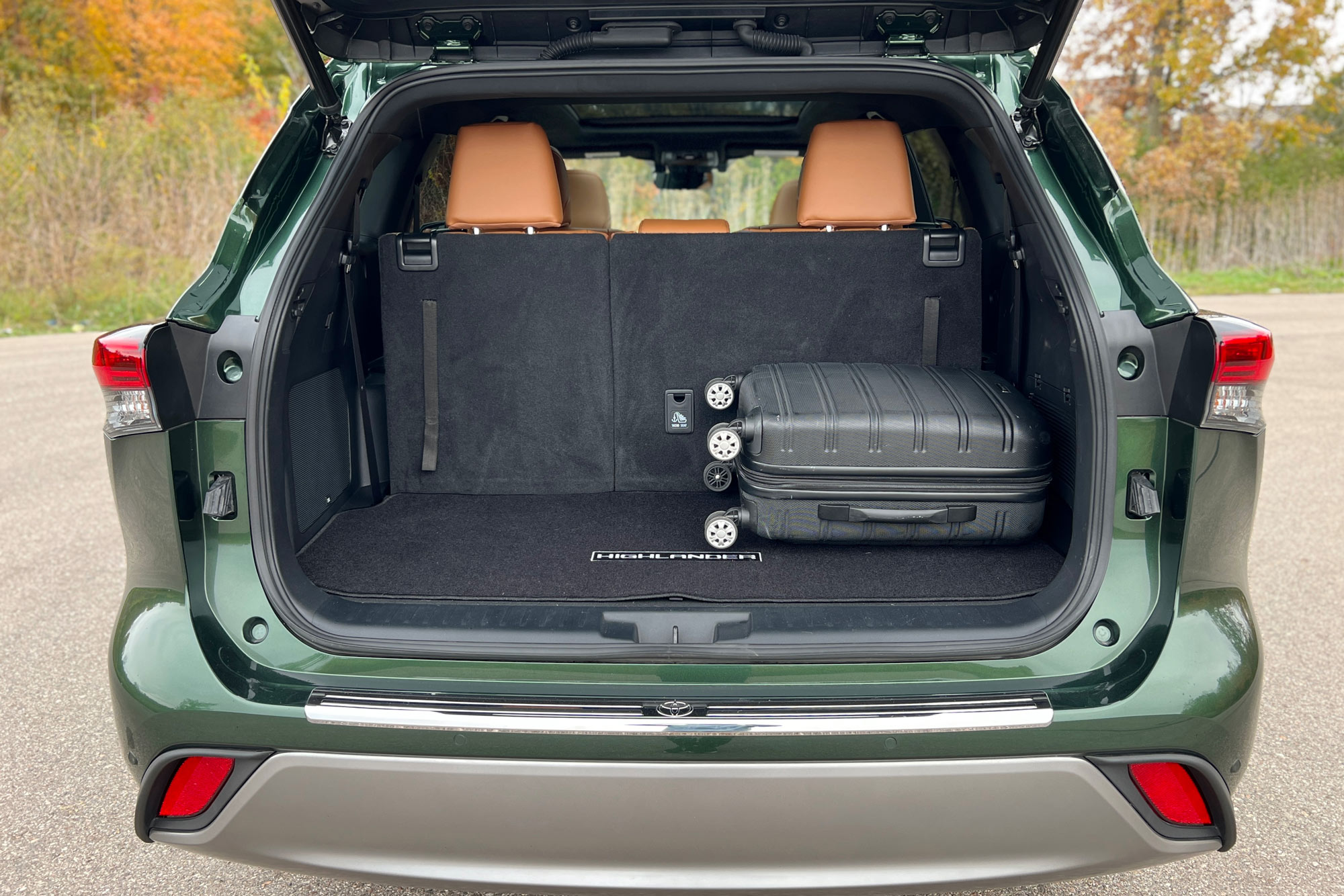 Beverly Braga
Beverly Braga
The Third Row Forces a Choice Between Seats and Stuff
With the third row utilized, cargo space is rather limited at 16 cubic-feet. A standard carry-on suitcase will fit only if positioned sideways, upright, or sideways upright. If the seats are reclined to their farthest position, hard-side luggage will be battling for space supremacy. The 60/40-split seats should allow for Tetris-level sorting of people and things.
Fold down the last row, and the cargo volume opens to a practical 48.4 cu-ft. Although the captain's chairs do not fold flat, the bench seat does in a 60/40 split. With the second-row bench and third-row seats folded, the Highlander offers a generous 84.3 cu-ft of capacity.
Storage nooks and other pockets appear throughout the interior. A notable example is the location of the wireless smartphone charger. Last year, Toyota relocated this feature from the center console bin to the dashboard, thus expanding the area's functionality and overall sense of space. My 18-ounce stainless steel water bottle had ample room inside the center console. When not in use, the charging shelf doubles as an alcove for non-tech items.
 Beverly Braga
Beverly Braga
Highlander Highs and Lows With Toyota Audio Multimedia Infotainment System
A Toyota Audio Multimedia infotainment system is standard for the Highlander lineup. Depending on the trim level, it includes an 8.0-inch or 12.3-inch touchscreen, and upper trims offer an 11-speaker JBL audio system. The larger screen and upgraded sound are standard for Highlander Limited and Platinum trims.
Pairing my phone was straightforward, and activating Apple CarPlay was as simple as a single tap on the settings screen. Wireless CarPlay and Android Auto are both available. Switching between the native Toyota system and CarPlay did become a hassle when the CarPlay icon didn't appear, but a vehicle restart remedied the problem.
One item of note: The Highlander's infotainment system doesn't have a dedicated home screen like some of its competitors. Instead, a left-side column featuring five standard icons for navigation, music, phone, vehicle, and settings serves as the main menu. Apple CarPlay and Android Auto will appear as a sixth icon at the top of this column when available. The main screen will display information based on the selected menu icon.
Despite plenty of ambient noise courtesy of hard rainfall and rough roads, the Highlander's voice assistant recognized natural speech patterns accurately when navigating to addresses and responded well to vehicle setting adjustment requests.
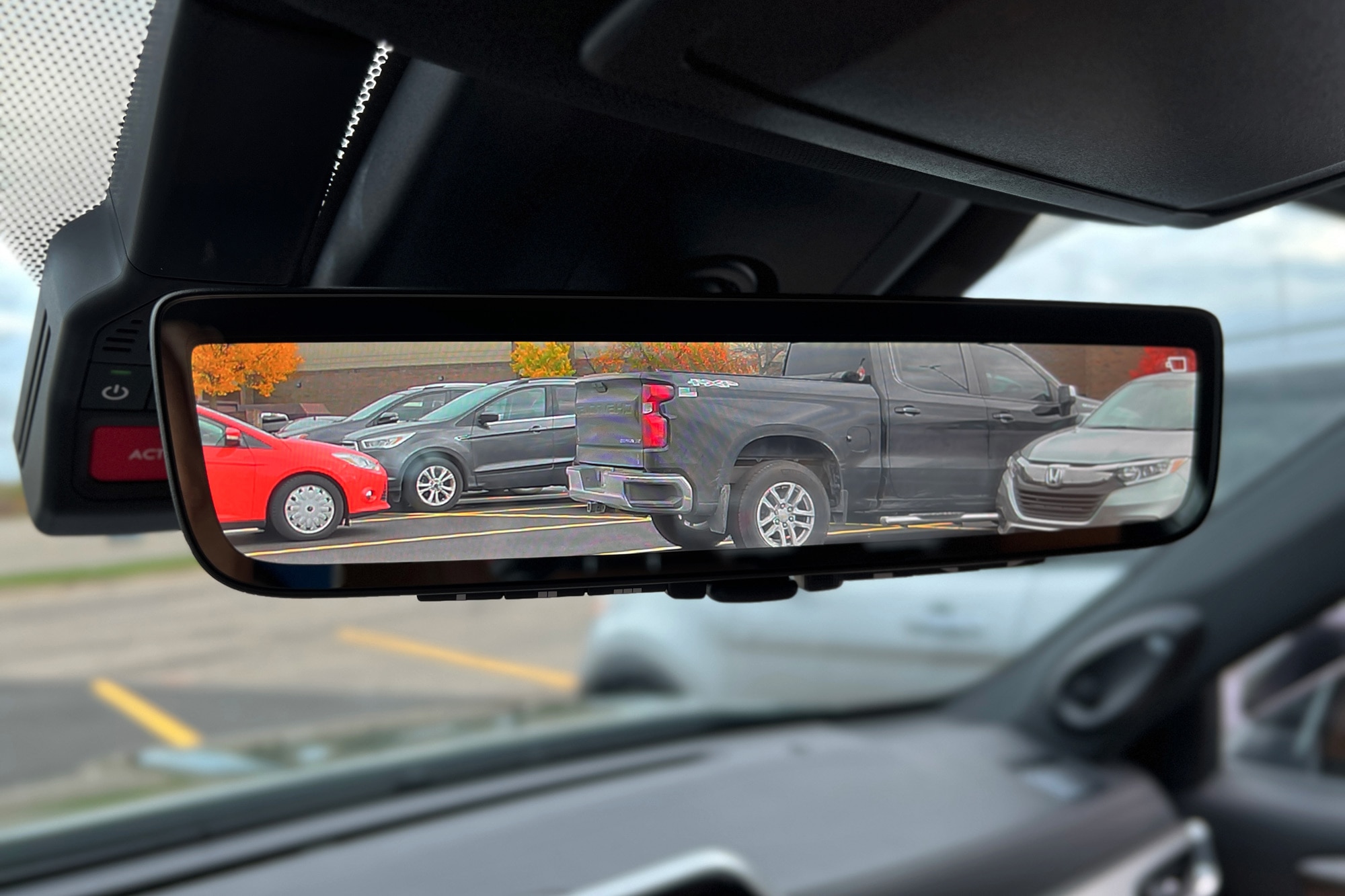 Beverly Braga
Beverly Braga
More Screens to Monitor What You're Doing Wrong
The 2024 Highlander offers some decent non-entertainment tech, such as a standard 7.0-inch information display for LE, XLE, and XSE trims. Upper-level Limited and Platinum models receive a 12.3-inch version of the digital gauge cluster.
A backup camera with a projected path feature is standard, while Highlander Limited and Platinum add dynamic guidelines. A Panoramic View Monitor that offers a 360-degree surround-view camera, including a curb view, is standard for Highlander Platinum but available on Limited. The Platinum trim includes a 10.0-inch color head-up display and a digital rearview mirror.
The mirror projects an unobstructed view of what's behind the vehicle. That is helpful when the third row is occupied, the headrests are up, or you've packed cargo to the roof. Supposedly, the feed is a wide-angle shot, but I considered it low definition in image quality. The perspective is also significantly skewed. When street parking, vehicles behind me appeared to be nearly bumper to bumper. But when using the 360 camera, I saw the other car was, in reality, a couple feet away.
During my test drive, I spared myself unnecessary anxiety and utilized the digital rearview mirror on an as-needed basis. Otherwise, it's yet another screen to cause eye fatigue.
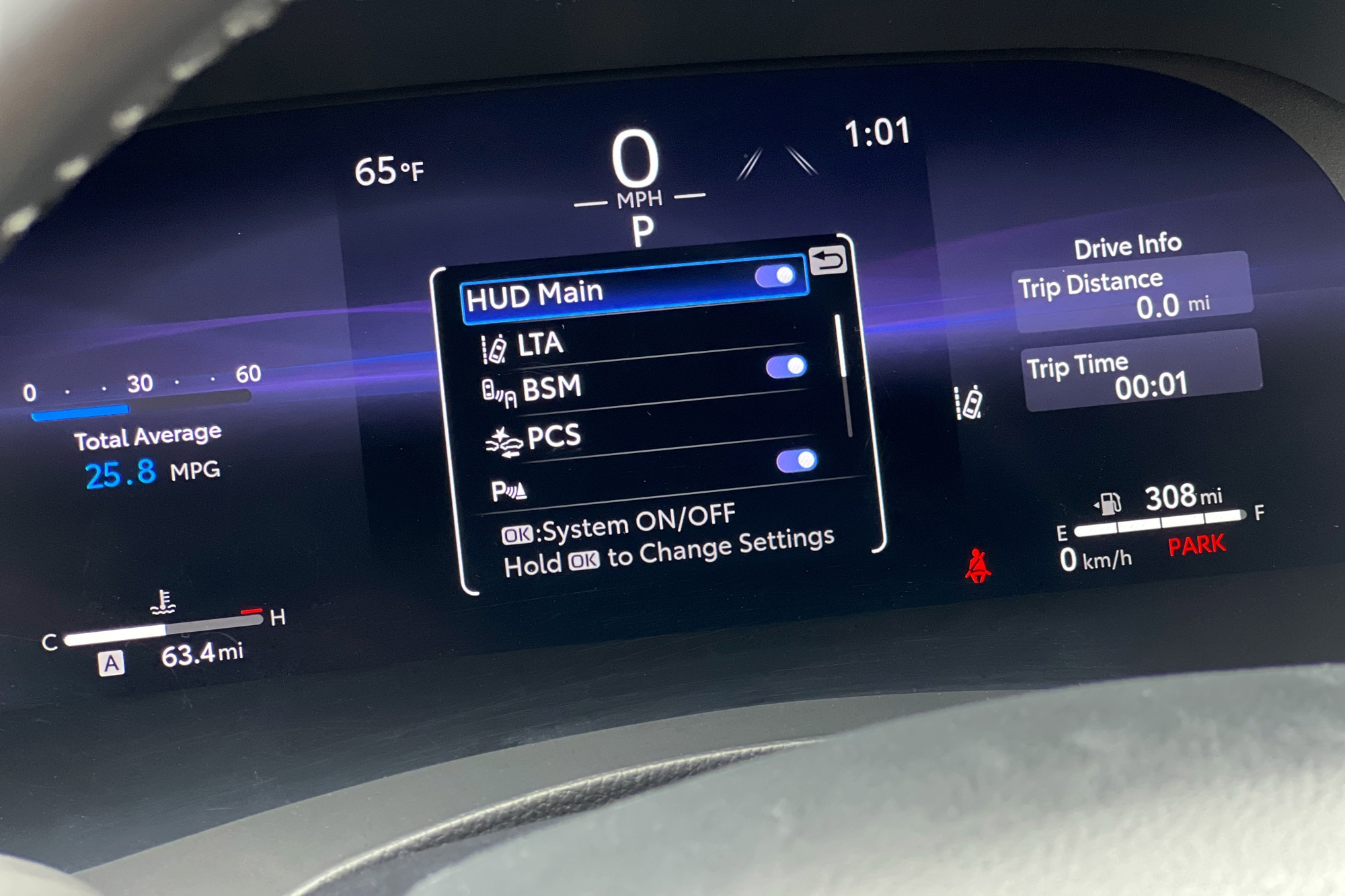 Beverly Braga
Beverly Braga
Toyota Safety Sense 2.5+ Offers a High Level of Active Safety as Standard
The list of Highlander advanced driving-assistance systems (ADAS) is extensive and is standard on all trim levels.
During my test drive, the adaptive cruise control worked exceptionally well, but I felt the lane departure and lane tracing features left much to be desired.
The adaptive cruise control is easy enough to operate using the steering wheel-mounted controls for speed and following distance. While driving through an extended highway construction zone with lots of last-minute stops and starts, the system transitioned smoothly between acceleration and deceleration. There were minimal jolts when braking, and upon re-acceleration the Highlander conservatively regained speed but was not slow.
On the other end of the safety spectrum, I couldn't consistently tell if the systems designed to keep the Highlander in its lane, and centered there, were active, assisting, or asleep. When the roadways were clear to do so, I'd allow the vehicle to drift outside of its lane. Whether in the center, edge, or along a curve, sometimes the vehicle corrected its trajectory, but usually it didn't. I found it baffling.
The plus side is that the lane-keeping systems would audibly scold me when veering off too quickly and widely. None of the other Toyota ADAS offered a warning beep or chime. For some, this tranquility is a blessing. For me, an audible alert is desirable if the vehicle and I are going off script, especially when changing lanes.
2024 Toyota Highlander Safety Ratings
The National Highway Traffic Safety Administration (NHTSA) gives the 2024 Toyota Highlander an overall safety rating of five stars, its highest rating. That applies to both FWD and AWD models. As of publication, the Insurance Institute for Highway Safety (IIHS) has not rated the 2024 Toyota Highlander. Check the
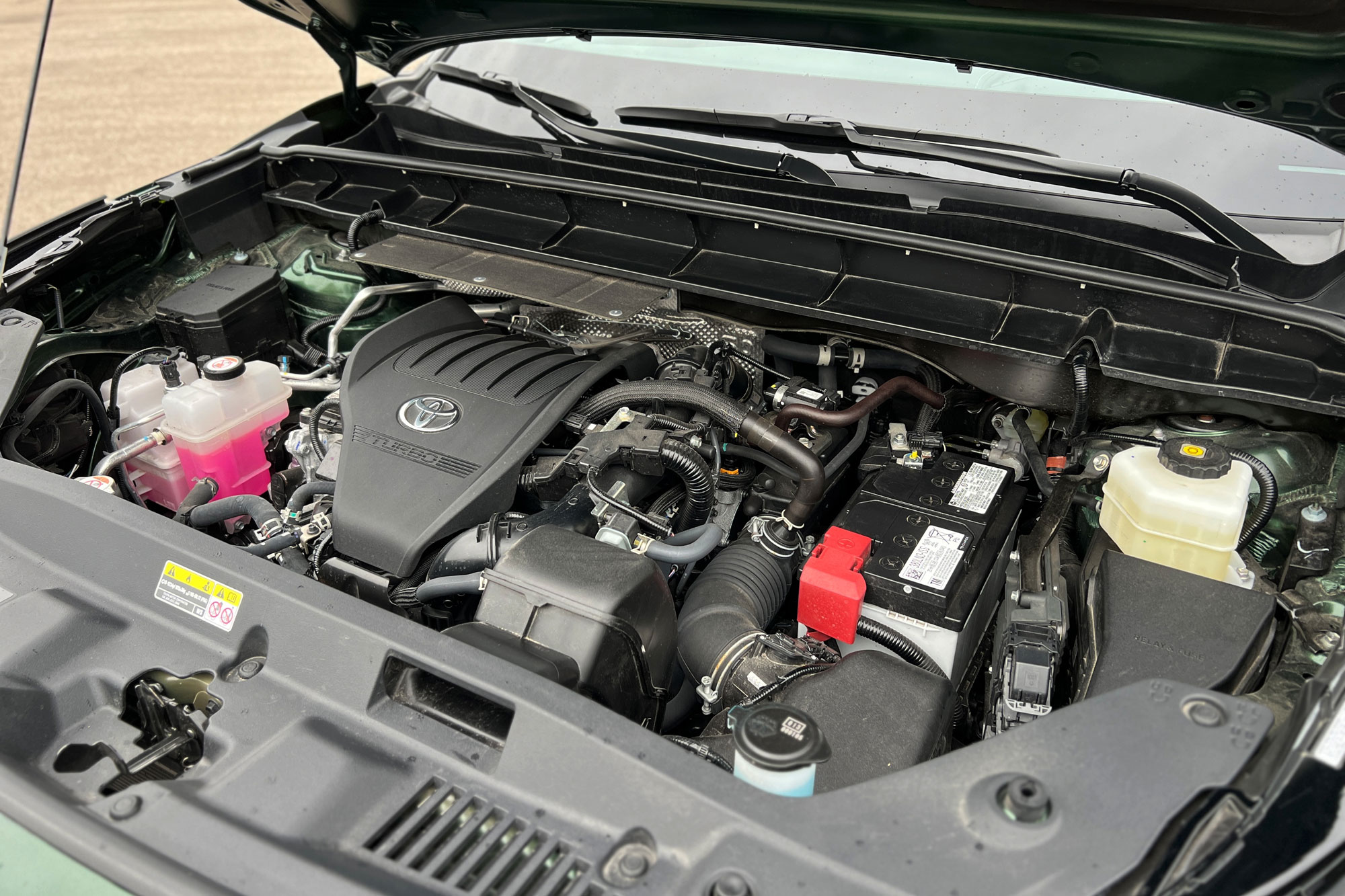 Beverly Braga
Beverly Braga
Highlander Gas Models Showcase Fuel-Efficient Power
The gasoline-powered Highlander comes with a turbocharged 2.5-liter four-cylinder engine. Toyota discontinued the previously available V6 last year. The turbo-four produces 265 horsepower and 310 pound-feet of torque. Although that represents a drop of 30 horsepower from the V6's power output, torque gets a 47 lb-ft boost. All Highlander gas models feature an eight-speed automatic transmission.
You can opt for AWD, and Toyota offers two distinct systems. With LE and XLE trim, the AWD system can send up to half of the available power to the rear wheels. A performance-oriented Dynamic Torque Vectoring AWD system is available with XSE, Limited, and Platinum models. The upgraded system also adds drive modes and a rear driveline disconnect, which automatically shuts off torque distribution to the rear wheels when traveling at highway speeds. With AWD, the Highlander can tow up to 5,000 pounds (unchanged from the old V6) and includes Trailer Sway Control.
Toyota estimates the 2024 Highlander will return 21/28/24 mpg in city/highway/combined driving with FWD. After 207 miles of mixed city and highway driving around southeastern Michigan, I averaged 23.4 mpg combined.
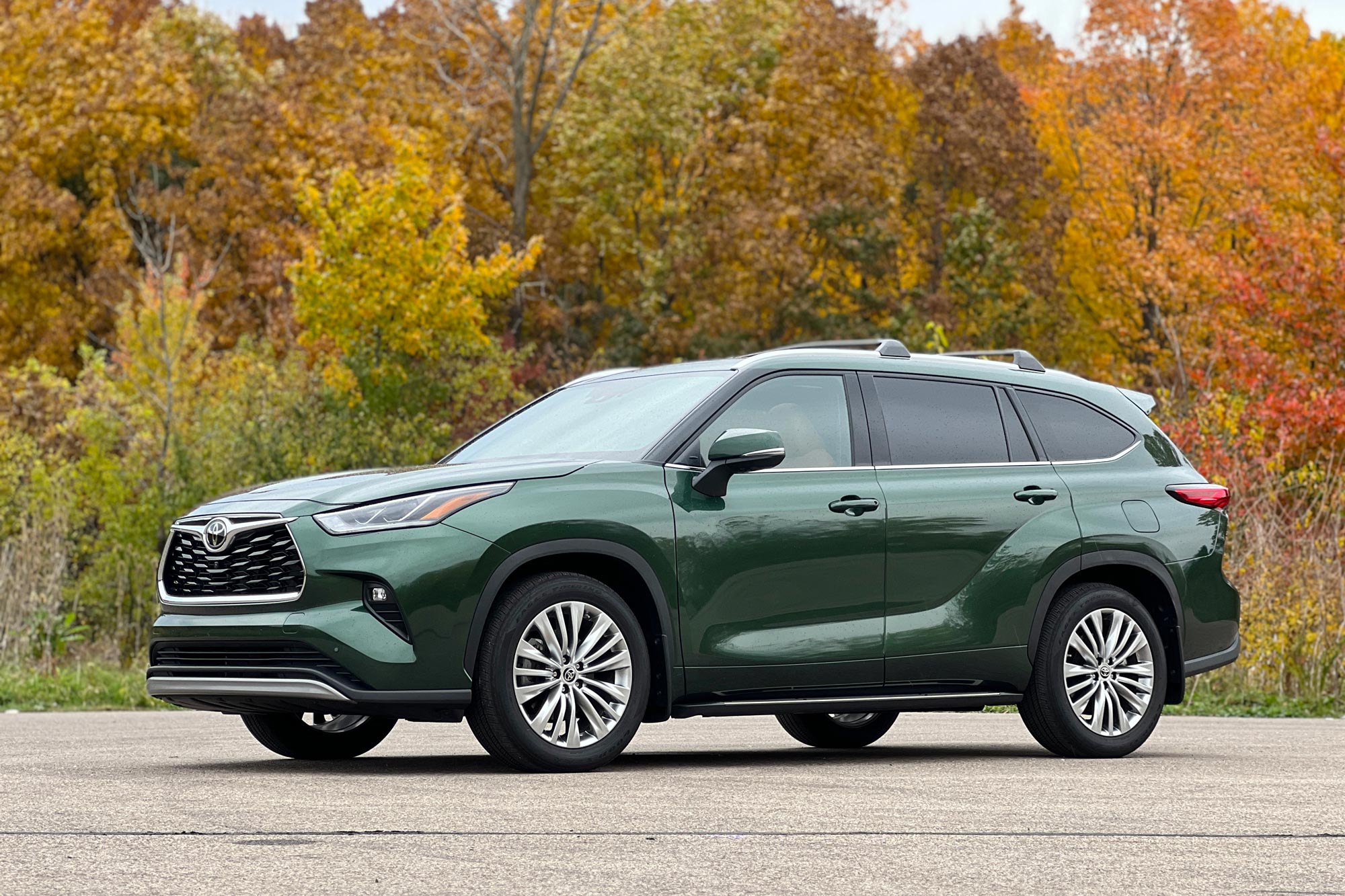 Beverly Braga
Beverly Braga
2024 Highlander Exudes Confidence and Maneuverability
With room for up to eight occupants, the 2024 Highlander is not lightweight. My Platinum AWD test vehicle was the heaviest of Highlanders, tipping the scale at 4,453 pounds. Although it felt heavy, the Highlander didn't drive like a slug. On-ramp acceleration and highway merging ability were sufficient because the turbo-four's improved torque offset the drop in horsepower compared to the old V6 engine.
In addition, I was pleasantly surprised by the amount of steering feel the Highlander offers. The responsiveness was, dare I say it, sporty — even in the Normal drive mode. Sport mode changes the powertrain responsiveness, but I didn't notice a significant adjustment to the steering effort level.
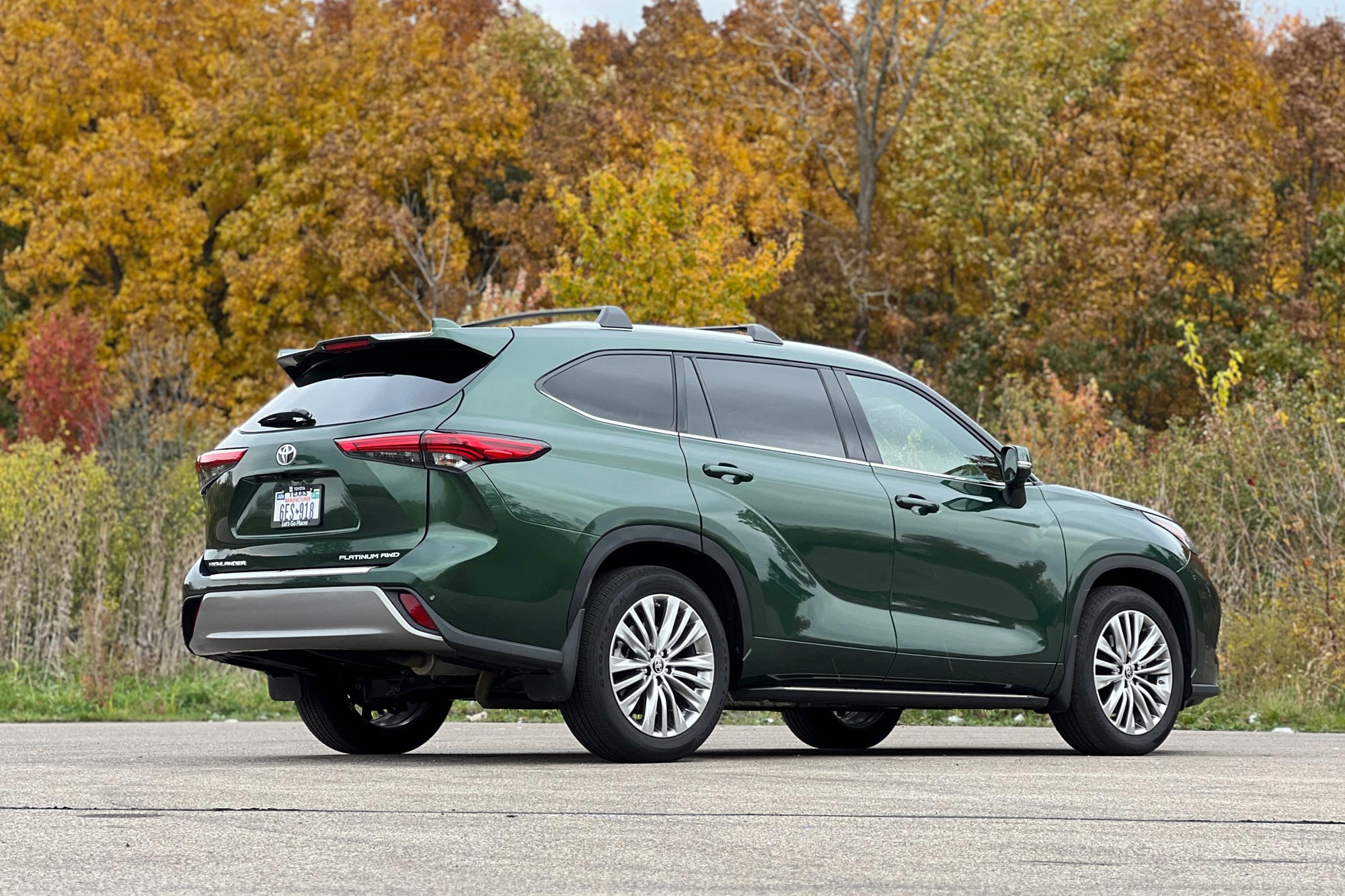 Beverly Braga
Beverly Braga
Choose Eco mode, however, and the Highlander suddenly exhibits a lackadaisical interest in throttle response and acceleration. But when aiming to benefit efficiency during city driving, ho-hum performance isn't a surprise.
The Highlander's ride quality is comfortable thanks to a suspension that happily absorbs Michigan's all-season road bumps and humps. On a specific stretch of U.S. Highway 23, the highway surface features tar-filled lines that usually create an annoying undulating sensation when I drive over them.
In other cars, stiff suspensions have usually meant incessant bouncing and rattling. That was not the case with the Highlander, which gently traveled on through, and with minimal road noise to boot.
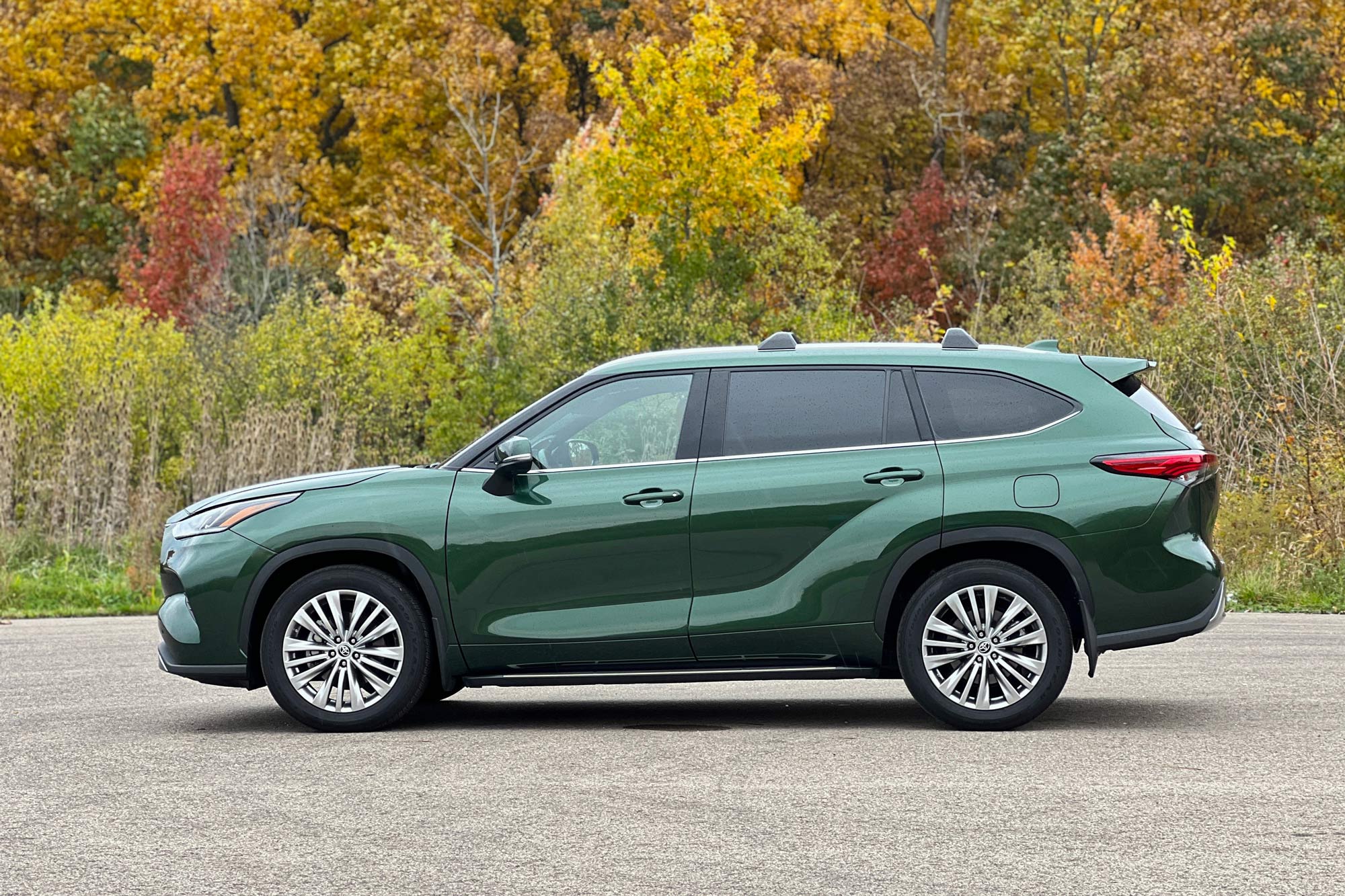 Beverly Braga
Beverly Braga
The Toyota Highlander Is Svelte, Sporty, and Seats Up to Eight
The 2024 Toyota Highlander is a surprise because it excels in the unexpected but falls short in the ordinary. There are three rows, but you have to trade-off cargo space for a seat or two. It has fun-to-drive mannerisms for an everyday crossover, even in Normal mode. The price point is in the $50,000s for what amounts to a basic family hauler with an attractive design, inside and out. The Toyota Highlander is hit-or-miss in some places, but in the end, I still found its quirks cute rather than questionable.
Written by humans.
Edited by humans.
 Beverly Braga
Beverly BragaBeverly Braga is a freelance writer and consultant with nearly 20 years of experience as a storyteller and communications professional. Her work has appeared in numerous print and digital outlets covering the automotive, entertainment, lifestyle, as well as food and beverage industries.
Related articles
View more related articles